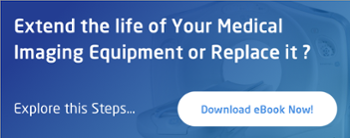Are you preparing to install new X-Ray equipment at your hospital, urgent care, practice, medical facility or veterinary clinic?  There are many elements and requirements to consider for this, and they vary from state to state.
There are many elements and requirements to consider for this, and they vary from state to state.
ECRI Director of Operations for Device Evaluation Jason Launders said, “Shielding calculations are quite complex and require a number of assumptions to be made, and it is really important the source of radiation is understood and everything has been taken into account.”
The National Council on Radiation Protection and Measurements (NCRP) has recommendations for radiation shielding designs. NCRP reports 147 and 148 are ideal for diagnostic imaging and NCRP 151 is for radiation therapy. Most physicists choose to base their designs on those national recommendations.
NCRP 147 and 148 recommend that X-Ray shielding be confirmed by a qualified expert after your install, but most states do not have this requirement. The rules are stricter for fluoroscopy, CT and radiation therapy.
Requirements vary from state to state. For example, Georgia requires shielding designs be submitted for approval but it can be done before, during or after construction. Iowa and South Carolina require shielding designs to be submitted before construction and Colorado doesn’t require submitted approval but an approved expert from the state has to have the design on file. Illinois requires shielding designs for CT and other X-ray equipment, but not for chiropractic offices.
This makes it challenging for those preparing to install medical imaging equipment. You can’t depend on national vendors to know all the requirements from state to state. That’s why you need to reach out to a physicist to make sure what your state requires. This can save you money and headaches.
What to Consider When Choosing Shielding Material
When selecting shielding material, it’s important to consider space, source strength and attenuation. Today, the main shielding materials used in construction include gypsum, lead or drywall and concrete, which often includes added materials to increase the attenuation. Lead is idea for smaller spaces but for high doses, you should choose a high-density concrete. It’s less expensive but does take more room. Lead is usually associated with toxicity concerns, but it’s not a problem once it is sealed inside the walls. Lead is stable and doesn’t release any toxic gases. The downside of lead? When it’s time to move, close or renovate your operation, lead has to be removed in a specific manner.
There is also a polymer-based shielding material that can be a replacement for lead sheets. It can be a cost-effective alternative to lead shielding. The sheets are installed on walls with adhesive backing. It’s also used to make curtains, shielded vests, barriers, nuclear medicine vials and interlocking bricks to provide thicker shielding.
The higher the energy, the more shielding is required. If your linear accelerator has a maximum photo energy above 10 megavolts, your machines is producing neurons. Lead-type shielding is great for photons, but terrible for neutrons. Make sure you are aware of photon and neutron attenuation so the right type of shielding can be selected.
The design process can take as long as 2-4 years, so it’s important to get it right. You should also factor in “worst case scenario” options.
Talk to an Expert
There are so many decisions to make when selecting medical imaging equipment. You want to avoid costly mistakes and know the options for getting the performance and warranties you need, at the most affordable cost. Talk to the experts at Atlantis Worldwide. Our clients have trusted us for 28 years!
Some blogs you may have missed:
- 4 Tips on X-Ray Tubes
- CR to DR: Digital Radiographic Upgrades And Options
- The 101 On Veterinary X-Ray Equipment
- MRI Infographic: Closed Bore, Open MRI & Wide Bore
- Six Key Considerations for Radiology Equipment Selection
About the author: Vikki Harmonay



